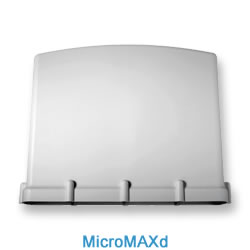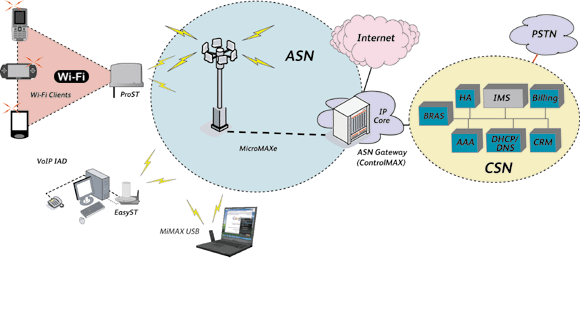+7 (812) 929-8283
Airspan MicroMAX
MicroMAX is a family of single mode (802.16d or 802.16e) highly integrated micro-cell base stations with all-in-one outdoor packaging of RF and base-band components. For Mobile WiMAX applications, MicroMAXe includes integrated dual RF transceivers to support two-channel MIMO. Performance optimized variants for high density roof-top deployments and cost optimized variants for low density / rural deployments are available.
MicroMAX family comprises of two products:
- MicroMAXe - an all outdoor solution for Mobile WiMAX applications to minimise physical footprint and operator OPEX
- MicroMAXd - an outdoor solution for Fixed WiMAX applications with an indoor traffic aggregator.
MicroMAXe
MicroMAXe is a sophisticated microcell Mobile WiMAX base station which employs the software defined radio (SDR) technology first developed for HiperMAX, together with dual radio transceivers, antennas and GPS receiver all in a highly integrated, physically small and light, all outdoor package.
MicroMAXe has been designed to provide a sophisticated yet costeffective base station solution in less dense deployment situations. The product supports a wide range of licensed and unlicensed frequency bands. The product has been designed to address the markets needs thru to 2011 and beyond by supporting the current and future air interfaces thanks to its SDR technology.
MicroMAXe base station product bringing together state-of-the-art technologies in a compact and all outdoor package. Thanks to its small footprint MicroMAXe is easy to deploy and minimises site OPEX expenditure.
MicroMAXe comes in two variants, a Hi-Power class and a Lo-Power class. MacroMAXe implements dual radios for 2x2 MIMO delivering up to 56 dBm EiRP with the integrated antennas.
MicroMAXe initially supports 5 MHz and 10 MHz channel sizes. However, the product is capable of supporting 20 MHz channels (Mobile WiMAX profile Rel. 1.5) as well. MicroMAXe has been designed to support either 2x10 MHz (using dual PHY/MAC) or 1x20 MHz channel.
MicroMAXe has been conceived for deployment in 3-sector configuration, which is the optimum configuration for Mobile WiMAX deployments. MicroMAXe design also incorporates an Ethernet switch which enables the traffic from 3 sectors to be aggregated for backhaul and network interfacing. MicroMAXe fully supports the interoperable R6 reference point for interworking with ASN Gateways either in a distributed or centralized network configuration.
Spectrum is a scarce and valuable resource which must be used efficiently. In order to achieve frequency reuse factor of one (N=1) the best balance between spectral efficiency and interference mitigation must be achieved. This is realised through Fractional Frequency Reuse for which MicroMAXe has been optimized. Fractional Frequency Reuse controls co-channel interference to support frequency reuse of one with minimal degradation in spectral efficiency. MicroMAXe can also be deployed using traditional frequency reuse plans.
Main Features
- Supports 802.16e-2005 SOFDMA
- Supports wide range of frequency bands
- 2.3 GHz, 2.5 GHz, 3.3 GHz, 3.5 GHz, 3.7 GHz, 4.9 GHz, 5.4 GHz, 5.8 GHz
- All-in-one single outdoor unit minimises deployment costs and site OPEX
- Dual 36 dBm radios
- STC and MIMO support
- Matrix A
- Matrix B
- Supports 5/10/20 MHz channel size
- 2x5 MHz
- 2x10 MHz
- 1x20 MHz
- Supports 512, 1024, 2048 FFT SOFDMA
- Supports interoperable reference points defined by NRM
- Supports interoperable R6 reference point
- Compact and light form factor
MicroMAXd

MicroMAXd is a complete standalone base station, sharing the same system architecture as our tried and tested ASWipLL product line.
The MicroMAXd base station is highly modular in design and consists of two main components: the all-outdoor Base Station Radios (BSR) and the indoor aggregator Base StationDistribution Unit (BSDU), or the single channel Data Adaptor.
Each base station site can contain up to 16 BSRs, depending on the amount of available spectrum. Each BSR is connected to the BSDU via a 100 BaseT interface operating over a CAT5 cable, which carries both data and power. Each BSDU can support up to 8 BSRs.
MicroMAXd is designed to support lower density, rural broadband access, enterprise applications and DSL in-fill scenarios in both licensed (1.5 GHz, 3.3 GHz, 3.5, 3.7 GHz, 4.9 GHz) andunlicensed (5.1, 5.4 GHz, 5.8 GHz, 5.9 GHz) bands.
One of the key features of the MicroMAX BSR is that it requires lessthan 28W power, making it ideally suited for those rural deployments where power generation and supply may be a problem.
MicroMAXd operating in unlicensed bands can be used by Wireless ISPs to deploy WiMAX easily and cost effectively wherever the need is identified.
Both MicroMAXe and MicroMAXd base stations are managed by Netspan, Airspan’s SNMP based element management platform.
Main Features
- Cost optimised for lower density applications
- Modular and scalable architecture
- All outdoor integrated baseband digital processing, radio and antenna
- Up to 16 radios per mast
- Radios connected to indoor aggregator using Cat5
- Cat5e (100m), up to 300m with Cat5 repeater
- Sophisticated radio implementation
- Supports WiMAX Forum™ profiles in 1.5 GHz, 3.3 GHz, 3.5 GHz, 3.7 GHz, 4.9 GHz, 5.1 GHz, 5.4 GHz, 5.8 GHz and in 5.9 GHz bands
- BPSK/QPSK/16QAM/
64QAM adaptive modulation - Full duplex FDD and TDD operation
- Advanced software features
- Full IEEE 802.16 QoS service classes
- Full 802.1d transparent bridging
- IEEE 802.1Q/p VLAN tagging/untagging
- Bridging and routing functionality
MicroMAX Network Diagram

MicroMAX Base Station Technical
| MicroMAXe | MicroMAXd | |
|---|---|---|
| Mobile WiMAX | Yes | No |
| Fixed WiMAX | No | Yes |
| Standards Compliance | IEEE802.16e-2005 | IEEE802.16-2004 |
| Form Factor | All Outdoor | Split Indoor / Outdoor |
| Frequency Bands | 2.3 GHz, 2.5 GHz, 3.3 GHz, 3.5 GHz, 3.7 GHz, 4.9 GHz, 5.4 GHz, 5.8 GHz, (700 MHz - Future) | 1.5 GHz, 3.3 GHz, 3.5 GHz, 3.7 GHz, 4.9 GHz, 5.1 GHz, 5.4 GHz, 5.8 GHz, 5.9 GHz |
| Channel Size | 20 MHz, 2x10 MHz, 10 MHz, 5 MHz | 10 MHz, 5 MHz, 3.5 MHz, 1.75 MHz |
| FFT | 2048, 1024, 512 | 256 |
| Duplex Method | TDD (FDD - Future) | TDD, FDD |
| Tx Power (Frequency band dependant) | Up to 2 x +36 dBm | +27 dBm |
| Maximum EiRP per sector | 56 dBm | 44 dBm |
| GPS Synchronisation | 8hr holdover, Integrated | Distributed |
| STC | Yes | No |
| MRC | Yes | No |
| MIMO | 2x2 | No |
| MIMO Matrix Type | Matrix A, Matrix B | No |
| CSM | Yes | No |
| Beamforming | No | No |
| Uplink Sub-Channelization | Yes | Yes |
| PUSC | Yes | No |
| Fractional Frequency Reuse | Yes | No |
| Dynamic Frequency Selection (DFS) | Yes | Yes |
| Ethernet CS | Yes (Future) | Yes |
| IP CS | Yes | No |
| IP version support | IPv6, IPv4 | IPv4 |
| Network Interface | 1000 bT Ethernet / R6 | 100 bT Ethernet |
| End to End VLAN (802.1Q) | No | Yes |
| Network VLAN Traffic Segregation | Yes | Yes |
| ASN Profile | Profile C | No |
| Supported Usage Scenarios | Mobile, Portable, Nomadic, Fixed | Nomadic, Fixed |
| Handover Supported | Yes | No |
| Encryption | AES | DES, AES |
| Authentication | PKM, PKMv2, EAP-TLS, EAP-AKA, EAP-SIM | PKM |
| Environmental (outdoor elements) | ETS 300 019-1-4 Class 4.1E | ETS 300 019-1-4 Class 4.1E |
| Environmental (indoor elements) | ETS 300 019-1-3 Class 3.2 |
Summary Note: Specifications are subject to change without notice and are for information purposes only.

